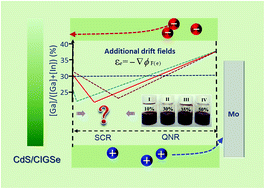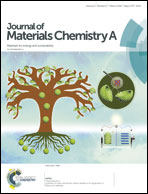Regulating the starting location of front-gradient enabled highly efficient Cu(In,Ga)Se2 solar cells via a facile thiol–amine solution approach†
Abstract
The introduction of a double-gallium (Ga) gradient plays a key role in pushing the performance of Cu(In,Ga)Se2 (CIGSe) solar cells to a more competitive level. In particular, the location of the front-gradient starting position strongly affects the barrier of the electron transport path, and this is not based on either significantly reducing the electron collection or decreasing the fill factor. Here we present and implement a double-Ga gradient design for CIGSe absorber layers using a diamine–dithiol solution approach. By regulating the front-gradient starting location, three CIGSe absorber layers with different Ga gradients were successfully constructed; these materials maximize solar spectrum absorption and improve the charge collection efficiency. Moreover, this facile solution-process approach does not require expensive vacuum equipment and can be applied to roll-to-roll printing technology. By combining optimal front-gradients with the back gradient, the short-circuit current has been increased by 17% and a maximum improvement in CIGSe efficiency to 13.12% achieved through adjusting the front-gradient to an optimum location.



 Please wait while we load your content...
Please wait while we load your content...